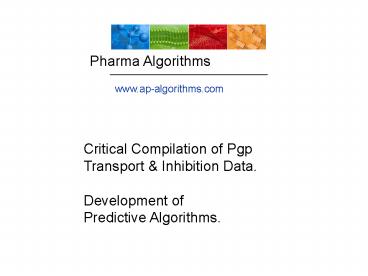Pgp Transport and Inhibition PowerPoint PPT Presentation
1 / 13
Title: Pgp Transport and Inhibition
1
Pharma Algorithms
www.ap-algorithms.com
Critical Compilation of Pgp Transport
Inhibition Data.Development of Predictive
Algorithms.
2
Importance
Design new CNS drugs
Design Anti-cancer drugs
Interpret and predict BBB,
Multi-drug resistance, Oral F,
Biliary excretion, Adverse effects
(drug-drug interactions)
Pgp extrudes compounds from a wide variety of
cells
3
Experimental Difficulties
No single assay can measure SPGP or IPGP directly
In Vitro data
BA/AB function of 1. Concentration 2.
Stirring rate 3. Pgp transport 4. Other
transporters
In Vivo data
Pharmacokinetic alterations
A very careful comparative analysis of different
assays is needed
4
Analyzed Data Types
Pgp Transport Assays
Polarized transport across MDR1 transfected cell
monolayers N 460
In vivo BBB with mdr1a(-/-) mice N 95
Pgp-mediated cell resistance to anticancer drugs
N 450
Pgp Inhibition Assays
Efflux inhibition of standard substrates
(calcein-AM, etc.) N 780
Reversion of resistance to MDR profile drugs
(paclitaxel, etc.) N 870
Indiscriminate Assays
Pgp ATPase modulation only useful if other data
is present N 135
Many QSAR specialists confuse modulation with
transport/inhibition
5
QSAR Problems Mistakes
How to describe broad specificity when there is
no stereo-specificity?
The instant desire is to jump into PLS, ANNs,
etc. and/or design 3D pharmacophores
Small data sets analyzed
1,000s explanations for each data point
Diffusion control ignored
Different assays confused(SPGP, IPGP,
modulation)
Poor models(sometimes called local)
How many alignments?
6
Good vs. Poor Models
Activity
pKa
Log P
80 Inactive
80 Active
7
Qualitative Analysis
Binary format
Pgp substrates SPGP 1, N 413 Non-substrates
SPGP 0, N 649 Pgp inhibitors IPGP 1, N
1,027 Non-inhibitors IPGP 0, N 695
Classification
Recursive partitioning with Physchem struct
descriptors
Deductive Approach
Ionization gt Size/H-B gt gt Class-Specific gtgt (3D)
8
C-SAR Results
One 2D plot is better than thousand correlations
Clear differences between substrates and
inhibitors
Substrates can be charged, inhibitors
cannot. Substrates depend on H-accepting,
inhibitors on log P. Substrates highly
class-specific, inhibitors not much
9
Substrates vs. Inhibitors
Inhibitors high permeability Easily cross
membrane(cannot be charged, log P gt 3)
Substrates variable permeability Enter, but
not cross membrane(can tolerate charge, log P -
any)
10
Predicting Algorithms
11
Validation
245 compounds compiled after development was
done. Entirely new publications, data from new
experimental hands. Both methods produced
comparable results.
12
Practical Calculations
Exp Databases
ADME predictions
Practical solutions
True or false results?
When to screen and not to screen?
How to select candidates for CNS development?
How to compare results of different assays?
Pgp Poster Auto-Builder Poster Oral F Poster
Batch calculations
ALP - Intranet calculations
13
Conclusions
Good ADME predictions arise from good
interpretations of many independent data sets
Good interpretations lead to the design of good
drugs
Good statistics alone does not lead to good
interpretations ? global computational traps
Thank You

